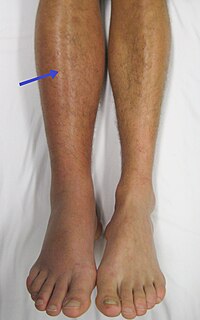
Photo from wikipedia
Background We report outcomes of spontaneous intracranial hypotension (SIH) patients who underwent transvenous embolization of cerebrospinal fluid-venous fistulas (CSFVFs) confirmed on digital subtraction myelography (DSM) performed at our institution. Methods… Click to show full abstract
Background We report outcomes of spontaneous intracranial hypotension (SIH) patients who underwent transvenous embolization of cerebrospinal fluid-venous fistulas (CSFVFs) confirmed on digital subtraction myelography (DSM) performed at our institution. Methods This is a retrospective evaluation of a prospectively collected database of SIH patients who underwent transvenous embolization of CSFVFs. Only patients who had fistulas confirmed on DSM performed at our institution were included. All patients had a baseline MRI and an MRI performed at least 90 days post-embolization, as well as clinical evaluation using the six item Headache Impact Test (HIT-6) and the Patient Global Impression of Change (PGIC) scales. Paired t-test was used to report changes in Bern MRI scores and HIT-6 scores at follow-up. Results 40 patients were included (29 female, 11 male). Mean age was 57.4±10.3 years. Mean Bern score improved from 5.7±3.0 at baseline to 1.3±2.0 at follow-up (p<0.0001). Mean HIT-6 score at baseline was 67.2±11.1 and at follow-up was 41.5±10.1 (p<0.0001). Median PGIC was 1, with 36 patients (90.0%) reporting at least minimal improvement and 32 patients (82.5%) reporting much or very much improvement. Complications included persistent local site pain in 12 patients (30%), suspected rebound intracranial hypertension requiring medical intervention in 7 patients (17.5%), and asymptomatic tiny Onyx emboli to the lungs in 3 patients (7.5%). Conclusions Transvenous embolization of CSFVFs using Onyx is safe and effective, resulting in significant improvement in headache and overall clinical outcomes in nearly 90% of patients, and substantial improvements in brain MRI abnormalities.
Journal Title: Journal of NeuroInterventional Surgery
Year Published: 2022
Link to full text (if available)
Share on Social Media: Sign Up to like & get
recommendations!